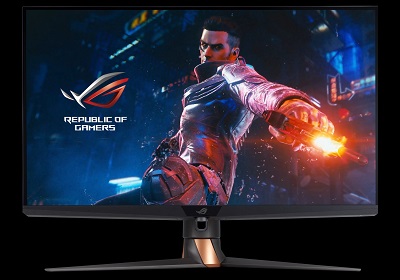ASUS PG32UQXE 160Hz 4K UHD IPS with G-SYNC Ultimate
As an Amazon Associate and Newegg Affiliate I earn from qualifying purchases made using the “Buy” button at the bottom of this post. Where possible, you'll be redirected to your nearest store. Further information on supporting our work.The ASUS PG32UQX delivers a stunning HDR performance and brings excellent contrast benefits to the table from its 1152-zone Mini LED backlight. But it’s also quite sluggish for a modern IPS-type panel, it’s very expensive and lacks HDMI 2.1 ports which limits its appeal to console gamers. The ASUS PG32UQXE of the ROG series shakes things up with a new panel and the inclusion of HDMI 2.1. Enabling 120Hz ‘4K’ output on games consoles such as the PS5 and Xbox Series X. It should be noted that the ‘UQX’ supported this via chroma subsampling and because not all HDMI 2.1 ports are equal it isn’t clear what sort of signal is supported on the ‘UQXE’. The top and side bezels are dual-stage, with a slim panel border flush with the rest of the screen plus a slender hard plastic outer part. The OSD (On Screen Display) is controlled by a dial and accompanying buttons beneath the central section of the bottom bezel. Based on current information it appears this model has done away with the ‘LiveDash’ mini display on the bottom bezel and also the ‘Aura RGB’ (Aura Sync) lighting at the bottom of the stand. Many would see these as unnecessary fripperies, anyway.
Apologies for ugly black background – this is the only image currently available.
The monitor adopts a 32” IPS-type panel, more specifically the M320QAN02.8 AHVA (Advanced Hyper-Viewing Angle) panel from AUO. This features a 3840 x 2160 (‘4K’ UHD) resolution and supports a 160Hz refresh rate with ‘G-SYNC Ultimate’ – including the G-SYNC module and with Adaptive-Sync support for AMD FreeSync also expected. Nvidia Reflex Latency Analyzer also features for full system latency measurement with a compatible mouse. Other aspects of note include a (presumably light to very light) matte anti-glare screen surface, 1000:1 static contrast ratio and 178°/178° viewing angles. The monitor is factory calibrated with a DeltaE <2 claimed, which also points to an sRGB emulation setting being included. A flicker-free Quantum Dot Mini LED backlight solution is employed with 576 dimming zones – an FALD (Full Array Local Dimming) solution panel manufacturer AUO refers to as ‘AmLED’ (Adaptive Mini LED). This provides a 97% DCI-P3 colour gamut (99% Adobe RGB expected based on panel) and an HDR peak luminance of 1000 cd/m²+. The monitor supports VESA DisplayHDR 1000, allowing it to respond to HDR10 content in a very dynamic way. Putting its Mini LED solution and generous colour gamut to good use alongside 10-bit colour processing.
Currently no response time is specified, though such specifications can be misleading anyway. We expect this iteration of the panel to be more capable in terms of pixel responsiveness than that used on the ‘UQX’. The stand is likely to feature various adjustments including tilt, height and swivel (plus possibly pivot into portrait) and we expect provision for 100 x 100mm VESA mounting. The ports include but aren’t limited to; DP 1.4 (with DSC), HDMI 2.1, 2 HDMI 2.0 ports and USB ports. Further details can be found on the ROG microsite. We’ll include further information on confirmed specifications, price and availability when we have it. We’d expect this to comfortably undercut the ‘UQX’ variant on price and sit closer to the Acer X32 at ~$2000 USD.


